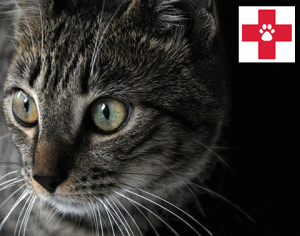In Part 1 and Part 2 we looked at how to approach an ill or injured cat; in this final part of the series, we will be talking about how to manage specific emergencies and conditions. Remember, this is first aid – it is intended to help you provide emergency care to your cat before you get them to us, not to replace proper treatment! 
What constitutes an emergency?
An emergency is any situation you find your cat in where their life or welfare is unexpectedly threatened. In more practical terms, we need to see them ASAP if…
- They have open wounds or are unable to take weight on a leg.
- They have lost consciousness (even if only for a short while) or have had a fit or a seizure.
- They are collapsed or unable to stand.
- They are struggling to breathe (in cats, this usually means they are breathing through their mouths or panting – this is deadly serious).
- They seem to be in pain.
- They are unable to pass urine or faeces.
Now, to finish off this series, we’ll briefly look at how to manage a range of different common situations, while you wait to get them in to see us.
Road traffic accidents (RTAs)
Cars moving at speed can cause a huge amount of damage to a cat’s body; however, cats are very good at getting out of the way and only then collapsing. This is why cats who have been hit by cars often manage to limp or crawl home, even if they have very serious injuries.
On assessing a cat after an RTA, it is quite likely that the full extent of their injuries won’t be apparent – internal bleeding, diaphragm ruptures and crush injuries can be hard to distinguish from “simple” shock. These cats should be handled and moved as little as possible and brought to us as rapidly as you can – please call ahead so we know you’re coming in and can get set up! Even if the injuries seem minor, we need to see them – some conditions (like lung bruises) seem fine until a few hours later, and can then rapidly become life-threatening without urgent treatment.
Cat fights
Cats are solitary hunters, and if they find a strange cat invading their hunting grounds, are likely to respond violently. Most cat fights result in superficial wounds and scratches, but if a tooth or claw goes deeper under the skin it can set up a “Cat Bite Abscess” which is really quite a nasty thing. Often, you won’t realise that they’ve been in a fight until a few days later when the abscess starts to grow. These aren’t usually life-threatening, but they do need to be seen by one of our vets for the best treatment (antibiotics, pain relief and often drainage of the pus). Make an appointment within the next day or so unless your cat is really sore or unwell in themselves; it is also helpful to bathe any wounds with warm salty water.
Eye injuries
These are most commonly due to cat fights – when quarrelling, cats don’t fight fair, instead, they slash with their claws at their adversary’s weak spots, like the eyes. This often results in “corneal lacerations”, slashes and cuts on the front of the eye. Often, the only symptom is a runny eye that the cat holds closed. These can usually be treated effectively, but eyes are fragile so need seeing as soon as possible.
Breathing difficulties
Open mouth breathing or panting is highly unusual in a cat and often suggests a serious respiratory problem (although it can also occur with diseases like cat-flu). Any difficulty breathing, or altered breathing rate is an emergency. Put the cat in a box, keep it quiet and calm, and get them to us ASAP.
Burns
Most burns are relatively superficial, but they’re really painful, so don’t get hurt yourself! The best treatment, in general, is to run cold water over the burn for at least 5 minutes, then get them to us for treatment. That said, if the burn is really large or deep (with obvious charring around the edges, for example) it may not be painful because the nerves have been burned away. If the burn seems moist or oozy, cover it with cling-film before cooling it (to reduce fluid loss) and then get them to us asap.
They’ve been exposed to something poisonous
Cats are sensitive to a wide range of different poisons, including many plants, most human medicines, and a number of household chemicals like cleaning agents, antifreeze and paint. If your cat is behaving abnormally or seems to be covered in some strange material, call us for advice straight away.
Fits or seizures
Fits are fairly uncommon in cats, and are usually due to poisoning, metabolic diseases (like diabetes mellitus), or injury to the brain (such as a stroke). While your cat is having a fit, it is best to leave them in a quiet, dark place to recover. They can’t “swallow their tongues” so don’t put your fingers in their mouth, don’t try to stroke them or talk to them (it can prolong the seizure), just let them recover. You can bring them in the be checked out once they’re over it. The exception is any seizure lasting more than a couple of minutes, or if they have multiple overlapping fits. These are medical emergencies that need seeing right now if we’re going to save their life.
If your cat is suddenly ill or injured, call us for advice!
